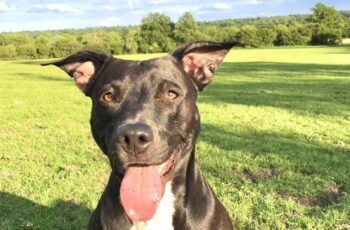
Your pet’s oral health is an important part of your cat and dog’s overall wellness. Naturally, your cat and dog may have different dental needs depending on their breed, age, or size. Fortunately, we sat down with Trupanion veterinarian Dr. Sarah Nold to learn more about what you need to know about cat and dog dental care and tips to help keep your best friend healthy and happy.
Cat and dog dental care

Wellness can come in all forms for your furry friends. Also, this may mean taking care of your pet’s teeth and gums daily. Whether you have a puppy, kitten, or adult pet, it’s important to look into proper dental care right from the start. Nold points out what to consider when starting your pet’s dental care regimen.
“Dental care includes regular oral exams and dental cleaning by your veterinarian is important to help prevent and treat dental disease. If issues are found before they become more advanced they’re more likely to be reversible with treatment. As dental disease progresses it can impact other organs of the body, including the liver and kidneys. While home care options like tooth brushing and dental chews help control plaque and the development of calculus, it’s rarely sufficient by itself. It’s still recommended to visit their veterinarian to get their teeth and gums checked frequently.”
Consider talking with your veterinarian about a dental care home regimen and when you should start brushing your pet’s teeth. They can help you with getting your pet on a proper schedule and help provide tips on what to expect with your furry family member.
What to look for in your cat and dog’s oral health

You may have questions when it comes to your pet’s dental health. For example, how do you know if something more is going on with your best friend? After all, your pets may not always let you know if they’re feeling sick. Nold breaks down what to look for when it comes to your furry friend’s teeth, mouth, and gums.
Consider the following:
- Bad breath
- Red gums
- Bleeding from the mouth
- Difficulty chewing
- Decreased appetite
Oral health problems can happen for several reasons. If your pet is experiencing any signs of discomfort, please take your pet to the veterinarian. They can help determine the cause of your pet’s pain and recommend a treatment plan.
Causes of pet dental health problems
Just like in humans, dental health can be connected to other health conditions. Proper oral health can affect your pet in a wide variety of ways. According to the American Veterinary Medical Association, “Periodontal disease is the most common dental condition in dogs and cats – by the time your pet is 3 years old, he or she will very likely have some early evidence of periodontal disease.”
Nold points out some of the dental health issues that may come up with your best friend.
“Some causes of dental health problems in dogs and cats that are often influenced by genetics may include retained baby teeth, crowded teeth, crooked teeth, misalignment of the teeth, or an abnormal bite. Diet and the overall health of your pet are also a factor in the development of your pet’s dental disease. Also, other issues that may need to be addressed are tooth resorption, fractured teeth, and oral masses. It’s also important to note that home care focuses on prevention of the development or progression of dental disease, it’s not going to treat your pet’s dental disease that’s already present.”
Trupanion claims data
We sat down with the Trupanion data team to get a further look at your dog’s and cat’s health when it comes to pet dental claims. While you may not always think of your pet’s teeth as something that may be costly, check out this list of stats from the team.
Consider the following:
- The average annual cost for a broken tooth in a dog: $700-$900
- Broken teeth are the 10th highest driver of veterinary cost for dogs
- Senior pets spend 3-4 times as much on dental care as young pets
- Cats spend 34% less than dogs on dental claims
- Small dogs spend 40% more on dental claims than other dogs
Dog breeds and dental health
While every dog is different, some dog breeds may be more prone to pet health conditions than others. For example, “Some dogs and cats, particularly those that are flat-faced and teacup dog breeds, are at a much higher risk of developing dental disease and at a younger age. For this reason, they often require additional dental care,” says Nold. Take a look at some of the dog breeds who most frequently claim for dental conditions.
Top dog breeds for dental conditions:
Your pet may need dental care when you least expect it

“The little biscuit decided that 2020 was the year to randomly pop up with dental issues. I mean, I get it, I think we all felt like it was the longest year of our lives. Some overgrown gingival tissue removal, two extractions, three fillings, and a $1,871 reimbursement later—you could say we’re pretty dang glad Mo is covered by Trupanion.”
For more on Cosmo’s story, read here.
Tips to help keep your dog and cat’s teeth healthy

Talk to your veterinarian
If you have any questions about your pet’s dental care, please talk to your veterinarian. They can help provide tips, recommendations, and give you best practices when it comes to your cat or dog’s dental health.
Brush your pet’s teeth daily
Although brushing your pet’s teeth may not be easy, it can be beneficial for your cat and dog’s overall health. Consider starting slow, take breaks, and provide pet treats to help provide a positive experience.
Pet teeth cleaning tools
There are a variety of pet products and tools that can be used to help keep your cat and dog’s teeth shiny and clean. First, to get started you’ll need a pet toothbrush, pet toothpaste, and dental chews. Also, a pet finger brush is another option to consider if a standard pet toothbrush doesn’t work for your best friend.
Provide pet-safe chew toys
While there are a variety of pet-safe toys and products available, you may want to be mindful of which items you give to your furry friends. After all, the last thing you want is your puppy to end up with a broken tooth! Also, when it comes to your puppy or kitten they may need specific toys to encourage safe chewing and play. Consider softer materials for puppies, but nothing something they can eat or chew apart. For an additional resource on pet-safe chew toys, check out this guide.

Cat and dog dental care is beneficial for your pet’s lifetime
Whether this is your first time brushing your puppy’s teeth or you’re a seasoned pro when it comes to your adult dog or cat, proper dental care is important for pets of all ages. But by talking with your veterinarian, sticking to your pet’s treatment plan, and providing a calming and positive environment for teeth brushing, your cat and dog will have a perfect smile in no time at all!
For more on pet health, read What You Need to Know About Diabetes in Dogs and Cats
Terms and conditions do apply. We love informed decisions. See our policy for full coverage details.
Trupanion is a registered trademark owned by Trupanion, Inc. Underwritten in Canada by Omega General Insurance Company and in the United States by American Pet Insurance Company, 6100-4th Ave S, Seattle, WA 98108. Please visit AmericanPetInsurance.com to review all available pet health insurance.


